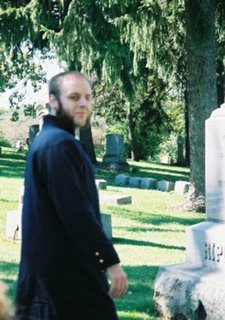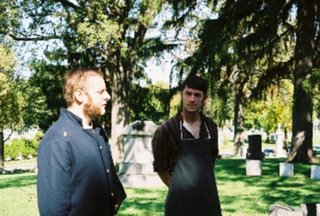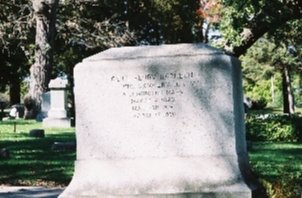 After taking our leave of Ebenezer Brigham, we continued up the hill a ways, where we encountered a couple of old friends, Lucius Fairchild and Andrew Ward (Cam Shimniok and Matt Kenyon), who served together in the 2nd. Wisconsin Infantry as part of the famed “Iron Brigade.” The Iron Brigade was a mostly Wisconsin company known for its reputation for its courage and tenacity in battles at Bull Run, Gainesville, Antietam (the Civil War’s bloodiest battle), and Gettysburg. The Iron Brigade suffered the most casualties of any brigade in the Civil War.
After taking our leave of Ebenezer Brigham, we continued up the hill a ways, where we encountered a couple of old friends, Lucius Fairchild and Andrew Ward (Cam Shimniok and Matt Kenyon), who served together in the 2nd. Wisconsin Infantry as part of the famed “Iron Brigade.” The Iron Brigade was a mostly Wisconsin company known for its reputation for its courage and tenacity in battles at Bull Run, Gainesville, Antietam (the Civil War’s bloodiest battle), and Gettysburg. The Iron Brigade suffered the most casualties of any brigade in the Civil War.Fairchild enlisted in the army in 1861 in the Wisconsin volunteer infantry, rose through the ranks to colonel. During the first day's fighting at Gettysburg in 1863, Fairchild’s men fought fiercely against an advancing line of rebels, with 233 of his 302 men killed, wounded or reported missing, and Fairchild himself had his left elbow shattered by a bullet, and it was Fairchild’s good friend and army surgeon, Andrew Ward, who amputated his left arm. Fairchild was captured by the rebels when they took the town, but was left behind during their retreat.
Promoted to brigadier general before being mustered out of the service, Fairchild served as secretary of state of Wisconsin from 1864 to 1866. He became Wisconsin’s first three-term governor in 1866, after which he was appointed U.S. consul at Liverpool in 1871 and then consul general at Paris.
 Andrew J. Ward served the 2nd Wisconsin for three years and saw to 900 wounded at The Wilderness in only a matter of days. His wife Eleanor accompanied him during those years and aided him in battle hospitals. She was said to be "cheerful and courageous" even in the harshest of conditions and loved by all who met her. Andrew Ward returned to Madison with the rank of lieutenant colonel, where he was a “wholesale and retail dealer in drugs and medicines” on King Street.
Andrew J. Ward served the 2nd Wisconsin for three years and saw to 900 wounded at The Wilderness in only a matter of days. His wife Eleanor accompanied him during those years and aided him in battle hospitals. She was said to be "cheerful and courageous" even in the harshest of conditions and loved by all who met her. Andrew Ward returned to Madison with the rank of lieutenant colonel, where he was a “wholesale and retail dealer in drugs and medicines” on King Street. By far, the liveliest character we met on the tour was that of Henry Harnden. Descended of seafarers, Harnden was a world traveler and adventurer, sailing to the coast of Africa at age 18. By the age of 23 he had visited numerous islands in the Pacific and explored the entire west coast of South America. In 1850 he headed to California to try his hand at mining, before traveling to Wisconsin where he opened a sawmill.
By far, the liveliest character we met on the tour was that of Henry Harnden. Descended of seafarers, Harnden was a world traveler and adventurer, sailing to the coast of Africa at age 18. By the age of 23 he had visited numerous islands in the Pacific and explored the entire west coast of South America. In 1850 he headed to California to try his hand at mining, before traveling to Wisconsin where he opened a sawmill.Harnden joined the 1st Wisconsin Volunteer Cavalry in July 1861 and rose through the ranks to become lieutenant colonel. On March 13, 1865, he was brevetted to colonel and to brigadier general. It was about this time that the story he had to tell began. On May 6 of that year, Harnden received orders to lead a Wisconsin detachment of 150, their mission to capture Jefferson Davis. Portrayed by Tom Lodewyck, Harnden captivated the crowd in his convincing and animated telling of how he and his men tracked Jeff. Davis and, after a brief friendly-fire encounter with the 4th Michigan, finally captured the rebel at Irwinsville, GA on May 10.
 Harnden mustered out of the service in July 1865 and settled in Madison where he raised Jersey cattle, owned a grocery on State Street and served as trustee to the Soldiers’ Orphans Home (more on that later). He served one term in the State Assembly (1866), as was also U.S. Assessor (1867-1873), and U.S. Collector of Internal Revenue (1873-1883). He died of pneumonia at his home in 1900, survived by his widow and four children.
Harnden mustered out of the service in July 1865 and settled in Madison where he raised Jersey cattle, owned a grocery on State Street and served as trustee to the Soldiers’ Orphans Home (more on that later). He served one term in the State Assembly (1866), as was also U.S. Assessor (1867-1873), and U.S. Collector of Internal Revenue (1873-1883). He died of pneumonia at his home in 1900, survived by his widow and four children.Due to controversies over the capture of Jefferson Davis, Harnden wrote a short book, The Capture of Jefferson Davis (1898), which can be read online here. It truly is a fascinating and daring tale, whether or not you are a Civil War buff (which, believe it or not, I am not--though I do find it an interestingperiod in history).





1 comment:
Cool! :-)
Post a Comment